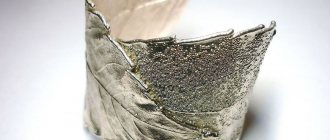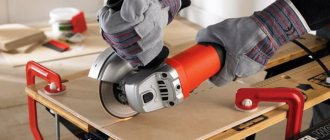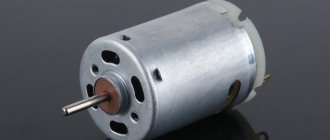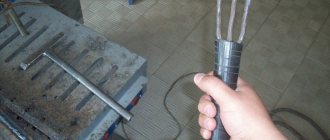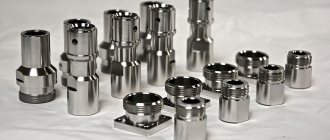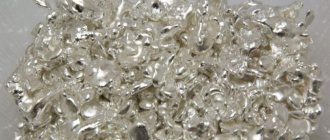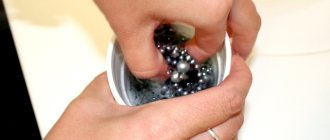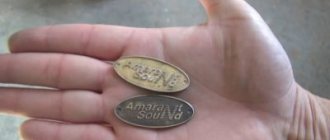What metals are plated with silver? When is metal silvering necessary?
Silver plating is required in cases where the product is to be given the properties of a precious metal of the highest standard.
Typically, objects made of copper, aluminum, steel, and brass are subjected to the silvering process. Cutlery made from cupronickel, nickel silver, and monel must be silvered, since these alloys can oxidize upon contact with food.
It is easiest to silver light-colored metals. To give dark materials the properties and color of pure precious metal, a sputtering thickness of about 15 microns will be required.
Electroplating decoration
Silvering of metal is suitable for the following items:
- Titanium. Usually BT-1 alloy is coated, other materials are difficult to process;
- Steel. It is possible to coat the material with a silver layer, but additional nickel or copper plating will probably be required;
- Bronze. The material easily “adheses” to silver molecules, which allows you to quickly apply a protective coating;
- Brass. When working with such an alloy, there is no need to apply an additional protective layer;
- Cupronickel or nickel silver. Treatment is necessary for everyday use of the material, as it allows it to become hypoallergenic;
- Copper. The material has a hardness similar to silver. The coating will improve electrical conductivity;
- Precious metals. Silver, gold, platinum are some of the most preferred elements for electroplating;
Interestingly, not only metals are coated with silver. For example, the substance silvermedin is used to form a protective coating in plants.
Silvering by heating
Silver plating can be carried out using other technologies. To carry out the procedure, you need to prepare a special solution. The list of required ingredients includes the following:
- silver chloride - 100 g;
- potassium bitartrate - 600 g;
- table salt - 0.6 kg.
All prepared substances are placed in one container and filled with water at the rate of 3 tablespoons of dry powder per 5 liters of water. Next, the dishes are placed on the fire and the liquid is brought to a boil; the items that need to be processed are placed in this solution and boiled for 30 minutes.
After this procedure, the metal surface of the products acquires a matte silver coating. To give galvanic silver its characteristic shine, it must be processed in a new solution. To create the mixture you need to prepare:
- water - 4.8 l;
- sulfide sodium salt - 300 g;
- vinegar-lead salt - 100 g.
Read also: Cold welding for brass
The components are thoroughly mixed. And then they need to be heated to a temperature of 70-80 degrees. Place the necessary items in the liquid and keep them there for a quarter of an hour. After treatment, the metal surface becomes silver and acquires a characteristic shine.
There is another easy way to coat copper jewelry. It is also carried out by heating.
To make the solution you will need the following:
- water;
- silver chloride, it can be obtained from 25 g of silver nitrate;
- potassium bitartrate - 150 g;
- regular salt.
The resulting mixture in the amount of three tablespoons should be added to water (5 l) and brought to a boil. Objects that need to be silvered are dipped into a boiling solution in a special sieve made of clay or porcelain. During processing, it is necessary to continuously stir the liquid using a glass or wooden rod.
Electroplating silvering at home is quick, easy and effective. Step-by-step instruction
Electroplating silvering at home can be done in several ways that do not require expensive chemicals.
With the galvanic method, you will need to connect the workpiece to the cathode, and the silver item to the anode. Under electrical influence, silver molecules will begin to collect in the electrolyte on the workpiece, which will become a protective coating.
Let's look at the electroplating process step by step.
Prepare the necessary tools
The process will require:
- Plastic or glass dielectric container of suitable sizes;
- Electrolyte;
- Silver;
- DC source;
- Holder for fixing;
It is also recommended to purchase jewelry scales, since you will need to measure reagents with an accuracy of up to a gram. You can purchase the necessary equipment cheaply via the Internet, at auto and building materials outlets.
Prepare solutions and chemical reagents
The composition of the solution depends on the alloy of the object being processed. Silvering of copper is possible using the following essence:
- Silver chloride - 10 grams;
- Sodium carbonate - 45 grams;
- Potassium cyanide - 45 grams;
- Sodium chloride - 20 grams;
- Aqueous solution of ammonium hydroxide - 80 ml;
There are several types of electrolytes for silvering, including:
Hydrogen electrolyte with soda
Sulfur dioxide electrolyte for silvering contains:
- Silver chloride - about 20 grams per sheet of mixture;
- Potassium hexacyanoferrate - about 20 grams per liter;
- Soda ash - about 30 grams per liter;
The electrolyte will be characterized by a reaction at low current concentration and room temperature.
Electrolyte and soda
Hydrogen electrolyte with potash
The heating of such an electrolyte can be increased to 750 °C, and the cathode concentration of electricity can be increased to 2 A/dm2.
Silver plating using special pastes
Applying a layer of silver using special pastes is a rather labor-intensive process, but these methods can also be used at home. One of the options for mechanical silvering involves applying a paste made from silver nitrate (lapis pencil) to the surface of the product. This paste is prepared in two stages:
A 10% solution of table salt is slowly poured into an aqueous solution of silver nitrate (6.7 g/l) until the precipitation of silver chloride stops. The resulting precipitate is filtered off and washed.
Silver nitrate is added to an aqueous solution (200 g/l) of sodium hyposulfite. The solution is filtered and mixed with ground chalk to obtain a viscous paste.
The surface of the product is wiped with the resulting paste and, as a result, a thin layer of silver is formed on the surface.
Another version of the paste for silvering is a mixture of 6 grams of silver chloride, 8 grams of table salt and 8 grams of potassium tartrate. The reagents are thoroughly mixed and crushed to a powder state. The resulting mixture is diluted with water immediately before application to the part.
The article discusses the main methods of applying silver plating, which can be implemented at home or in a small workshop. Once again we draw your attention to the need to comply with safety requirements.
You can find out how the process of galvanic and chemical silvering occurs in industrial conditions, process modes, electrolyte compositions and the features of the technical process in the “ Silver Plating ” section of our website.
You may be interested in the following articles:
|
Nuances of galvanic silvering
Do-it-yourself electroplating is a rather complicated procedure. To achieve a positive result, it is necessary to take into account the properties of the material being processed, take precautions, and carry out the process in accordance with strict sequence.
It is worth considering that independent galvanic silvering cannot seriously enhance the strength of the alloy; the result is aimed, rather, at performing a decorative function. To obtain an impressive protective layer, the procedure must be carried out about 10 times in a row.
The thickness of the coating during a one-time procedure is thinner than a human hair (about 20 millionths of a meter).
It is better to clean and degrease the surface to be treated
The product to be treated can first be degreased with alcohol or sandblasted. Sanding with special pastes or sandpaper is also suitable.
Features of silver coating of different metals
Many metals can be silvered: brass, aluminum, steel and other alloys. During the process, reactions occur that provoke the release of metallic silver, which is responsible for the creation of the characteristic silver coating.
There are a number of features of the silvering process under different conditions:
- The composition of the mixture must be selected based not only on the quality of the product, but also on its further practical purpose.
- Light metals are easier to plating. The coating thickness for parts made of dark material must be at least 15 microns.
- The surface of any alloy must be thoroughly cleaned and degreased before the silvering procedure.
Silvering of copper and copper alloys
Silvering of copper is no different from silver plating of other types of products. Copper is not a capricious metal and can be easily processed. However, it is this type of metal that is most susceptible to the formation of oxides and corrosion, and therefore additional preparatory measures in the form of polishing may be necessary before silvering.
Alternative methods of silvering metals
Silvering metal at home is possible in a number of alternative ways. They will require special reagents, as well as compliance with safety measures.
Other silver processing methods include:
Chemical surface treatment
The technology involves the use of chemicals that bind to the material being processed, forming silver microparticles.
The basis of the chemical treatment is antichlorine, a special reagent used in the photography industry. You will also need:
- Formalin - about 10 drops;
- Ammonia - about 10 drops;
- Sodium thiosulfate - 1 liter;
The processing itself looks like this:
- Formaldehyde and ammonia are added to the antichlorine.
- Clean the surface of the metal product, then immerse it in a boiling soda solution. Afterwards, rinse with running water.
- The product must be immersed inside a container with antichlorine and left for 2.5 hours.
- After removing the item, it must be washed and dried.
Polishing silver plating
Immersion technology
How to silver plate metal using the immersion method? With this method, the product being processed is immersed in a silvering essence, which consists of certain substances. The composition depends on the alloy of the product.
Chemical method
Electroplating with silver using this method involves chemical exposure; the metal surface is treated with a special compound - antichlorine. These granules are used to capture photographs. The technology is as follows:
- First you need to prepare a solution; for this, add formalin (10 drops) and ammonia (5 ml) to 1 liter of antichlor. Mix everything thoroughly.
- The product that is planned to be silvered must be carefully prepared: the surface is cleaned to a shine, the object is boiled in a soda solution, and then washed well under running water.
- After all the procedures have been completed, the part is immersed in a photo solution and left for one hour.
Over time, a thin layer of silver forms on the surface. Now you just need to rinse the product under water, dry it and polish it thoroughly.
Copper silvering at home can be done using a different technology. Moreover, all the components that are needed for the procedure can be purchased in specialized stores at a very reasonable price. First you need to prepare the solution, for this you will need:
- antichlor - 300 ml;
- aqueous solution of ammonium hydroxide - 2 ml;
- formalin - 3 drops.
All components are mixed, a copper product is lowered into the solution, and the container is put away in a dark place for an hour and a half. After the time has passed, the item must be removed from the liquid. Let it dry on its own, and then rub it thoroughly with a soft cloth.
Section question - answer
Do-it-yourself silver plating using an anode and cathode, what is it?
Expert opinion
Andrey Seleznev
Chemist-technologist, Volgograd
Such galvanization of a house is the transfer of molecules when an electrical circuit is closed. The metal object being processed is connected to the cathode, and the silver object is connected to the anode. Silver molecules, under the influence of direct current, will begin to move to the cathode, becoming a protective layer.
Electroplating with silver, what GOST?
Expert opinion
Andrey Seleznev
Chemist-technologist, Volgograd
Even if the product is plated silver, it is based on a different alloy. For example, copper alloys in the Russian Federation are regulated by GOST 859-78.
How to do gilding on silver correctly
Let's take a closer look at the features of applying such a coating. Let us immediately note that the procedure, carried out in accordance with all the rules, involves applying a very thin layer of 999-carat gold to the surface of the silver jewelry. This is quite delicate work. After all, the thickness of the applied layer in this case is only 5-10 microns. In other words, we are not even talking about millimeters. Craftsmen can also make a layer between gold and silver, for example, from platinum. Such gold-plated products last much longer than with standard gilding. However, we should not forget that this technology requires not only appropriate equipment, but also a certain amount of knowledge. Regular gold plating is a simpler option. Even a novice master can easily cope with such a task.
Read also: What does a drilling machine consist of?
The basis for spraying is usually 925 silver jewelry. Externally, such products are difficult to distinguish from gold ones. At the same time, their cost is lower. It should also be noted that in addition to the external resemblance to gold, sputtering is completely safe for health. In addition, such jewelry does not corrode and practically does not oxidize. An equally important question is how long the applied gilding on silver lasts. In this case, it all depends on how competently the master worked. If everything is done in accordance with the technology, then the product will not soon lose its original appearance. At the same time, it is quite difficult to say exactly how long the gilding layer lasts, because everything depends on several factors.
Currently, there are several ways to apply gold plating to silver jewelry. Among them, gilding should be highlighted:
- using zinc;
- ether solution;
- sodium
However, the best option is the galvanic method. This method is also suitable for applying a layer of gold plating at home. In addition, you can cope with the task using fairly simple equipment. In this case, gold particles are applied to the surface of a silver product under the influence of electricity. In addition, you will also need an aqueous solution of salts here. In this case, the gold particles will be the anode, while the jewelry itself will be the cathode.
The process of applying a layer of gold plating looks something like this. First of all, we prepare suitable containers. Next, fill in the electrolyte. After this, we place the gold in the container. The precious metal must be dissolved by the electrolyte to form small particles. To do this, it must be exposed to electric current. Now you can lower the silver item into the solution. There is no need to do anything further. You just have to wait a while. As a result, the oxides should cover the silver product with a thin layer. Then we take out the decoration and wait until the gilding completely hardens. That's all. All that remains is to polish the decoration.
High-quality spraying significantly transforms the appearance of the product. Thanks to this coating, the average person is unlikely to distinguish it from gold. Moreover, even an experienced jeweler can be misled here. Of course, over time such jewelry becomes dirty. Therefore, it is important to know how you can restore their original appearance. To get rid of dirt, and at the same time prevent the removal of the top layer of gold, the procedure is done without the use of abrasives. Also, do not forget about accuracy. First of all, it is recommended to wipe the surface of the gold-plated jewelry with a dry cloth. It is best to use wool, suede or flannel for this procedure. After this, all contaminants should be removed from the surface. Here you can use turpentine or alcohol. Apply a small amount of your chosen product to the sponge and gently wipe the jewelry. This is quite enough to remove minor dirt.
Otherwise, you will have to carry out more thorough cleaning. Here it is important to choose a product that would not spoil the gilding. One option is a combination of laundry soap and ammonia. This mix is recommended to be used if an unsightly greenish tint appears on the surface of the gilding. This phenomenon is not uncommon for such jewelry. Grate a small amount of soap. For the cleaning procedure, 1 teaspoon of such shavings is enough. Dilute this amount in a liter of warm water and add 5 drops of ammonia. Mix the ingredients thoroughly. Then we lower the item requiring cleaning into the resulting solution and wait for about half an hour. Next, the jewelry must be washed under running water and wiped dry with a flannel or suede cloth.
We have already noted above that the gilding layer does not withstand mechanical stress. Therefore, experts do not recommend wearing such products too often. In other words, gold-plated silver jewelry is clearly not intended for everyday wear. Of course, this primarily concerns rings, chains and bracelets. In addition, you need to remember that gold plating oxidizes when exposed to sweat. Therefore, it is recommended to remove such jewelry during sports activities. They should also not be kept in direct sunlight. Accordingly, the window sill is clearly not the best place to store such decorations. Moreover, it is recommended to keep them separately from gold items. Direct contact in this case may well result in damage to the gold plating layer.
Table: cost of professional silver plating
Specialized companies offer galvanic work at an affordable price and in the shortest possible time. Professionals help you select the thickness, prepare the surface, and carry out final processing.
Contacting specialists will help you save your health, money and personal time.
The table below shows the average prices for electroplating work for jewelry, current for 2021:
| Service | Price | Minimum order price | The service includes |
| Full Coverage | 100 rubles per gram | From 1200 rubles | Cleaning and polishing of the product |
| Partial coating with electroplating pencil | 250 rubles per 1 cm2 | From 300 rubles | Cleaning and polishing of the product |
| Restoration of the coating | 150 rubles per 1 cm2 | From 300 rubles | Cleaning and polishing of the product |
For an additional cost, you can order polishing of the jewelry, which allows you to get rid of severe nicks and scratches.
Some tips
In fact, the silvering process is not as simple as it might seem at the very beginning. The procedure has a number of features that must be taken into account when performing, they are as follows:
- Most often, copper, brass or aluminum objects and products are subjected to the silvering procedure. During processing, these alloys, interacting with the solution, create a reaction, as a result of which they begin to release metallic silver. This is what allows this technological process to take place.
- The easiest way to coat light metal surfaces with silver. If products made of dark metal are used, then it is necessary to apply a layer at least 10-15 micrometers thick, otherwise the dark surface will show through and spoil the appearance.
- During the procedure, regardless of where it is carried out - at home or in a production facility, it is necessary to ensure good ventilation.
- To achieve a higher quality silver coating, you need to thoroughly clean and degrease the surface to be treated.
- It is advisable to apply special pastes that are used for silvering metal with a soft cloth or a small piece of leather.
These are the main methods of silver plating that can be used in an apartment. It’s quite possible to make them yourself, and the ingredients used for production are sold in the public domain.
Some silver compounds decompose when they come into contact with zinc, iron, copper and other metals, releasing metallic silver. This property of silver salts can be used to coat any metal surface with a layer of silver.
The following recipes for silvering metals are suitable for zinc, copper and brass. If it is desirable to silver plate another metal, then it must first be coated with a thin layer of copper.
- silver chloride 300 g;
table salt 300 gr;
exhausted chalk 200 g;
Step 1
. Mix these substances.
Step 2
. Clean the item completely from dirt and traces of fats or oils.
Step 3
. Rub with a raw piece of the above mixture.
Step 4
. Rinse with water and polish.
- silver nitrogen salt 100 g;
Step 1
. Both compositions are mixed.
Step 2
. Spread the resulting dough-like mass onto a woolen cloth. They rub the object with it.
Step 3
. The item is washed with water and rubbed with a piece of leather until it shines. The result is an even, beautiful layer of silver.
When using this recipe, we strongly recommend wearing rubber gloves and generally working with extreme caution, since potassium cyanide is one of the strongest poisons and you need to be extremely careful when working with it.
- silver chloride 300 g;
table salt 600 gr;
Step 1
. Mix silver chloride, cream of tartar and table salt in enough water to form a dough-like mass.
Step 2
. The resulting composition is rubbed onto the object. This mixture is usually used for silvering buttons.
- silver nitrogen salt 20 g;
distilled water 10 ml;
cyanide 50 g;
Step 1
. 20 g of silver nitrate salt are dissolved in 100 g of distilled water and a solution of 50 g of potassium cyanide in 100 g of water is added.
Step 2
. Both solutions are mixed well and filtered.
Step 3
. Separately mix 10 wt. tsp chalk with 1 wt. parts of cream of tartar and the resulting powder is mixed with the appropriate amount of the above filtered solution to obtain a not very thick mass suitable for application to objects.
Step 4
. After silvering, the object is washed, dried and polished.
Silver plating by wet method (immersion)
Read also: How to dissolve frozen polyurethane foam
Well-pre-cleaned items are dipped into a liquid prepared according to one of the following recipes:
- silver plating liquid;
carbon-silver salt 10 g;
sodium sulfide salt 100 g;
Step 1
. Dissolve salts in water with frequent stirring.
Step 2
. Drain the saturated solution from the undissolved sediment of carbon-silver salt remaining at the bottom.
Step 3
. Objects immersed in this solution are touched with a zinc stick (contact method of silvering).
- "Argentin" (liquid for silvering);
Nitrogen-silver salt 5.5 g;
Potassium cyanide 60 g;
Sodium sulfide salt 10 g;
Exhausted chalk 10 g;
- silver chloride 10 g;
ammonia 70 ml;
potassium cyanide 40 g;
crystalline soda 40 g;
Step 1
. To obtain thicker layers of silver, a mixture of these components is made. Add distilled water so that the total volume is 1 liter.
Step 2
. Objects are immersed together with a piece of zinc or placed on a zinc plate.
silver nitrogen salt 11 g;
potassium cyanide 60 g;
exhausted chalk 750 g;
Step 1
. A mixture is prepared from these components. Store it in a dark glass vessel.
Step 2
. When used, mix one part of the mixture with two parts of rain or distilled water and dip the object intended for silvering into it. Large objects are rubbed with a sponge or rag soaked in this mixture.
After silvering, the objects are rubbed with seasoned chalk and polished with a soft piece of leather.
Silvering when heated
- cream of tartar powder 600 g;
table salt 600 gr;
- silver chloride 100 gr.
Step 1
. Silver chloride is mixed with cream of tartar and table salt, a little water is added to form a liquid paste.
Step 2
. Store in a dark place in a well-sealed dark glass container.
Step 3
. Items to be silvered are immersed in a solution of the above components and boiled for 15-20 minutes. For 5 liters of water take 3 tablespoons of the composition for silvering. Silver plating is produced in a copper boiler. The objects are placed in a clay sieve, lowered into the cauldron with strong stirring, after which the object is immediately coated with a thin layer of silver.
Step 4
.
The resulting silver layer is beautiful and durable, but lacks shine. To add shine, objects removed from the solution are heated to 70-80° in the following solution: sodium sulfide salt 300 g;
vinegar-lead salt 100 g;
Step 5
. Lead sulphide begins to release from the solution, and after 10-15 minutes the objects receive the proper shine.
Step 1.
A concentrated solution of silver nitrate salt is added to a solution of sulfur sodium salt with a strength of 22° according to Baume until the precipitate that appears dissolves. The resulting solution is a silver plating liquid when heated. Long-term treatment with this solution gives a matte layer.
- potassium cyanide 35 g;
silver nitrogen salt 10 g;
Step 1
. Potassium cyanide is dissolved in 0.5 liters of water and silver nitrate salt in 0.5 liters of water is added to the solution.
Step 2
. The solution is heated in a porcelain or enamel container to 80-90° and objects are immersed in it.
Jewelry made of gold and silver are very popular nowadays. Which precious metal to choose is a matter of taste. Some people like gold jewelry, others prefer silver. It is also allowed to wear items made from these precious metals at the same time. For example, you can easily wear a large silver chain and complement the ensemble with a thin gold one. The main thing is not to wear too many items made from different precious metals at the same time.
However, another option is possible - applying a layer of gold plating to the silver jewelry. The main advantage of such products is their lower cost. After all, such a ring, for obvious reasons, will cost less than a similar gold one. At the same time, there is a high risk of becoming a victim of fraudsters. The thing is that such spraying can be done at home, and the gilding will last a long time, if, of course, everything is done correctly. The procedure itself is quite simple. You need to prepare the necessary equipment.
Security measures
Chemical silver plating must be carried out with proper precautions.
- For work you will need: closed-type glasses, rubber gloves, a rubberized apron, a respirator.
- The process is only possible if there is good ventilation or in the open air.
- Reagents must be stored separately from each other.
- Removing silver-plated objects from galvanic baths should only occur after removing the electrical voltage.
- Waste must be disposed of according to safety regulations.
